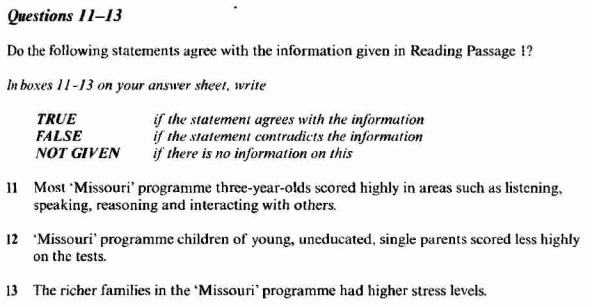剑桥雅思5:Test3雅思阅读PASSAGE 1真题+答案+解析
发布时间:2020-10-13 关键词:剑桥雅思5:Test3雅思阅读PASSAGE 1真题+答案+解析为帮助同学们学习,小编为大家整理了剑桥雅思5:Test3雅思阅读PASSAGE 1真题+答案+解析,希望能够对大家有帮助。关于剑桥雅思的资讯关注新航道北京学校剑桥雅思栏目。
Early Childhood Education
New Zealand’s National Party spokesman on education, Dr Lockwood Smith, recently visited the US and Britain. Here he reports on the findings of his trip and what they could mean for New Zealand’s education policy.
A
‘Education To Be More’ was published last August. It was the report of the New Zealand Government’s Early Childhood Care and Education Working Group. The report argued for enhanced equity of access and better funding for childcare and early childhood education institutions. Unquestionably, that’s a real need; but since parents don’t normally send children to pre-schools until the age of three, are we missing out on the most important years of all?
B
A 13-year study of early childhood development at Harvard University has shown that, by the age of three, most children have the potential to understand about 1000 words — most of the language they will use in ordinary conversation for the rest of their lives.
Furthermore, research has shown that while every child is born with a natural curiosity, it can be suppressed dramatically during the second and third years of life. Researchers claim that the human personality is formed during the first two years of life, and during the first three years children learn the basic skills they will use in all their later learning both at home and at school. Once over the age of three, children continue to expand on existing knowledge of the world.
C
It is generally acknowledged that young people from poorer socio-economic backgrounds tend to do less well in our education system. That’s observed not just in New Zealand, but also in Australia, Britain and America. In an attempt to overcome that educational under-achievement, a nationwide programme called ‘Headstart’ was launched in the United States in 1965. A lot of money was poured into it. It took children into pre-school institutions at the age of three and was supposed to help the children of poorer families succeed in school.
Despite substantial funding, results have been disappointing. It is thought that there are two explanations for this. First, the programme began too late. Many children who entered it at the age of three were already behind their peers in language and measurable intelligence. Second, the parents were not involved. At the end of each day, ‘Headstart’ children returned to the same disadvantaged home environment.
D
As a result of the growing research evidence of the importance of the first three years of a child’s life and the disappointing results from ‘Headstart’, a pilot programme was launched in Missouri in the US that focused on parents as the child’s first teachers. The ‘Missouri’ programme was predicated on research showing that working with the family, rather than bypassing the parents, is the most effective way of helping children get off to the best possible start in life. The four-year pilot study included 380 families who were about to have their first child and who represented a cross-section of socio-economic status, age and family configurations. They included single-parent and two-parent families, families in which both parents worked, and families with either the mother or father at home.
The programme involved trained parent — educators visiting the parents’ home and working with the parent, or parents, and the child. Information on child development, and guidance on things to look for and expect as the child grows were provided, plus guidance in fostering the child’s intellectual, language, social and motor-skill development. Periodic check-ups of the child’s educational and sensory development (hearing and vision) were made to detect possible handicaps that interfere with growth and development. Medical problems were referred to professionals.
Parent-educators made personal visits to homes and monthly group meetings were held with other new parents to share experience and discuss topics of interest. Parent resource centres, located in school buildings, offered learning materials for families and facilitators for child care.
E
At the age of three, the children who had been involved in the ‘Missouri’ programme were evaluated alongside a cross-section of children selected from the same range of socio-economic backgrounds and family situations, and also a random sample of children that age. The results were phenomenal. By the age of three, the children in the programme were significantly more advanced in language development than their peers, had made greater strides in problem solving and other intellectual skills, and were further along in social development. In fact, the average child on the programme was performing at the level of the top 15 to 20 per cent of their peers in such things as auditory comprehension, verbal ability and language ability.
Most important of all, the traditional measures of ‘risk’, such as parents’ age and education, or whether they were a single parent, bore little or no relationship to the measures of achievement and language development. Children in the programme performed equally well regardless of socio-economic disadvantages. Child abuse was virtually eliminated. The one factor that was found to affect the child’s development was family stress leading to a poor quality of parent-child interaction. That interaction was not necessarily bad in poorer families.
F
These research findings are exciting. There is growing evidence in New Zealand that children from poorer socio-economic backgrounds are arriving at school less well developed and that our school system tends to perpetuate that disadvantage. The initiative outlined above could break that cycle of disadvantage. The concept of working with parents in their homes, or at their place of work, contrasts quite markedly with the report of the Early Childhood Care and Education Working Group. Their focus is on getting children and mothers access to childcare and institutionalized early childhood education. Education from the age of three to five is undoubtedly vital, but without a similar focus on parent education and on the vital importance of the first three years, some evidence indicates that it will not be enough to overcome educational inequity.
儿童早期教育
新西兰党教育发言人Lockwood Smith博士最近访问了美国和英国。下面是他撰写的一份报告,文中阐述了他此行的收获以及这些收获对新西兰教育政策的意义。
A 《教育增进能力》是一份由新西兰政府儿童早期关怀和教育工作小组所作的报告,于去年8月出版。该报告呼吁促进机会均等、加强对儿童的关爱和对儿童早期教育机构的资助。毫无疑问,这的确是必要的。但是一般而言,家长直到孩子3岁时才把他们送到早期教育学校,这样一来,我们是不是错过了教育孩子的时期?
B 哈佛大学进行了一项长达13年的儿童早期发展的研究,结果表明:到了3岁时,大多数孩子已经具备理解1000个单词的能力,这些词汇是他们在以后的一生中进行日常对话时会经常用到的。
该研究还表明:尽管每个孩子都有与生俱来的好奇心,但是这种好奇心却可能在2岁到3岁时受到强烈的压抑。研究人员表示,人的个性是在出生后的两年中形成的,到了3岁的时候,孩子们已经掌握了将来在家庭和学校中会用到的基本技能。从3岁以后,孩子们就开始在已有知识的基础上继续拓展对世界的认识。
C 人们一般认为,家庭社会地位和经济条件不太好的孩子往往在学校表现不佳。不仅新西兰有这种情况,澳大利亚、英国和美国也都有这种情况。为了改变这种状况,美国于1965年在全国开展了一项“先发优势”计划,并投人大量资金。按照该计划,孩子在3岁时被送进早期教育学校,以帮助家境不好的孩子在学校取得成功。
尽管投人了大量资金,结果却令人失望。这可能有两个原因。首先,该计划所定开始年龄太大,许多3岁时进入早教学校的孩子此时已经在语言和智力发育上落后于他们的同龄人了。其次,这些孩子的家长并没有参与进来。每天放学后,这些孩子又回到了不利于他们成长的家庭环境中。
D 由于越来越多的研究表明儿童3岁前的时间是重要的,而且“先发优势”计划的结果又令人失望,所以,美国密苏里州实施了一项试点项目,其核心就是把家长作为孩子的任老师。研究表明:与家长合作而不是绕过家长,是帮助孩子获得人生起跑点的最有效方式。密苏里州的这个项目正是以这一研究成果为基础的。该项目为期4年,包含了380个即将迎来个孩子的家庭,涵盖了不同家庭经济状况、社会地位、年龄段和家庭构成,其中包括单亲家庭、双亲家庭、双职工家庭以及父母中有一方居家的家庭。
该项目派出受过专业训练的教育学家进行家访,与家长和孩子共同合作。项目提供了孩子发展的相关知识,以及孩子成长过程中要注意的事项。此外,该项目还提供在促进孩子智力、语言、社会和运动技能等方面的指导,定期检查孩子教育和感官(听觉和视觉)能力的发展情况,以及时发现孩子在成长和发育过程中的障碍,其中涉及到的医疗问题则由专门的医生处理。
教育学家亲自进行家访,对家长进行培训,并每月召开集体会议与那些新做爸爸妈妈的家长分享经验,讨论他们关心的问题。位于校内的家长资源中心则为家长和资助者提供关爱孩子的学习资料。
E 当密苏里项目中的孩子3岁时,研究人员将这些孩子与来自相同经济状况、社会地位、家庭状况的孩子以及随机抽取的同龄的孩子放在一起,共同进行评估。结果是惊人的。到了3岁的时候,参与项目的孩子在语言发育方面已远远领先于他们的同龄人。他们解决问题的能力和其他的知识技能得到了更明显的,在社会交往方面也取得了很大的进步。事实上,在诸如听力理解、口头表达和语言能力方面,参与项目的孩子一般都处于同龄人中前15%-20%的位置。
最重要的是,结果还表明传统意义上的一些不利因素,如家长的年龄和受教育程度、是否是单亲家庭等,与孩子所取得的进步大小和语言发育几乎没有任何关系。无论项目中的这些孩子所处的经济条件或社会条件如何不利,他们的表现都毫不逊色。虐待儿童的现象几乎完全消失了。人们发现惟一一个会影响孩子发展的因素就是由干家庭压力所导致的亲子交流质量不佳,而这种交流在较为贫困的家庭倒不差。
F 这些研究结果是令人激动的。在新西兰,有越来越多的例证表明家庭经济条件和社会背景不佳的孩子入学时的发育就不是很充分,但我们的教育体制却在延续这种劣势。而上述项目中创新的做法则可以打破这种恶性循环。与家长在家庭、单位中进行合作的理念与儿童早期关怀和教育工作小组的报告提出的观念形成了鲜明的对比。该小组所关注的是使母亲和孩子能得到儿童保育,并使早期教育制度化。3岁到5岁间的教育无疑是重要的,但某些实例表明:如果不重视对家长的培训,不重视孩子3岁前的时间,那么这种教育将无法克服教育上的差距。
剑桥雅思5Test3阅读Passage1答案解析


文章结构
体裁:说明文
主要内容:本文论述了新西兰政府对儿童早期教育重要性的科学认识,注意从以往的几次儿童早期教育试验项目中吸取经验教训,认识到不仅要重视儿童早期教育,而且要同样重视父母对儿童的教育。
结构:A 段:Introduction,从新西兰政府专门负责儿童早期教育的工作组报告谈起,指出儿童早期教育的重要性。
B 段:一项长达13 年的研究项目指出:3 岁之前的阶段是人类获取基本技能和知识的最重要时期。
C 段:1965 年美国实施一项名为“领先”的项目,旨在来自贫穷家庭的儿童的教育水平。但是由于文中所述的两个原因,项目最终未能达到预期目标。
D 段:美国实施“密苏里”项目,不仅重视儿童早期教育,同样重视家长对儿童的教育。该项目把重点放在后者。
E 段:“密苏里”项目产生良好效果,在该项目中受教育的儿童不管家庭背景如何,在学习各方面明显优于其他同龄人。
F 段:总结全文:新西兰政府从上述试验项目中得出结论,要重视儿童0—3 岁期间的教育,同时重视家长在这期间对儿童的教育
题目解析:Questions 5- 10
题型归类:Matching
Matching 考查考生对文章细节的把握和辨别能力。 此类题型一般难度不大,但由于需要在全文反复搜寻相关内容而可能耗费大量时间。因此在解题时,考生可以根据题目某一组比较明显的定位词先缩小搜寻范围,然后在定位词附近迅速搜寻正确答案。
Questions11-13
题型归类:TRUE/FALSE/NOT GIVEN
T/F/NG类题考查考生对文章细节的把握与辨别能力,考查题目中细节信息和逻辑关系是否与文章中完全对应。因此在解题时,先要确保读懂题目,准确理解题目意思,然后根据题目定位词回到原文定位相关内容后与题目进行对照判断。




